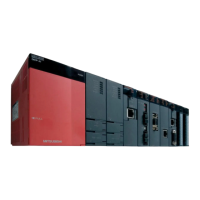275
CJ, SCJ, JMP
1
2
3
4
6
7
8
6.5 Program Branch Instructions
6.5.1 CJ, SCJ, JMP
JMP
(1) Unconditionally executes program of designated pointer number within the same program file.
Note the following points when using the jump instruction.
1. After the timer coil has gone ON, accurate measurements cannot be made if there is an attempt to jump the timer of a coil
that has been turned ON using the CJ, SCJ or JMP instructions.
2. Scan time is shortened if the CJ, SCJ or JMP instruction is used to force a jump to the OUT instruction.
3. Scan time is shortened if the CJ, SCJ or JMP instruction is used to force a jump to the rear.
4. The CJ, SCJ, and JMP instructions can be used to jump to a step prior to the step currently being executed. However, it is
necessary to consider methods to get out of the loop so that the watchdog timer does not time out in the process.
5. The device to which a jump has been made with the CJ, SCJ or JMP does not change.
6. The label (P*) occupies step 1.
7. The jump instructions can be used only for pointer numbers within the same program file.
8. If a jump is made to a pointer number inside the skip range during a skip operation, program execution will be taken up
following the pointer number of the jump destination.
P8
P9
Y42
X6
X3
P8
CJ
X7
P9CJ
Y40
X0
When X3 is
ON, the loop
is closed.
Exits the loop when
X7 is turned ON.
18
Y4C
X9
XB
Jumps to label P19
when XB turns ON.
Y43 and Y49 remain
unchanged regardless
of whether XB and XC are
turned ON/OFF during the
execution of CJ instruction.
16
14
10
P19
P19
CJ
Y49
XB
Y43
XC
18
Y39
M36
X8
16
14
10
P9
P9CJ
Y36
M3
Y30
M33
21
Y3B
X9
Occupies 1 step

